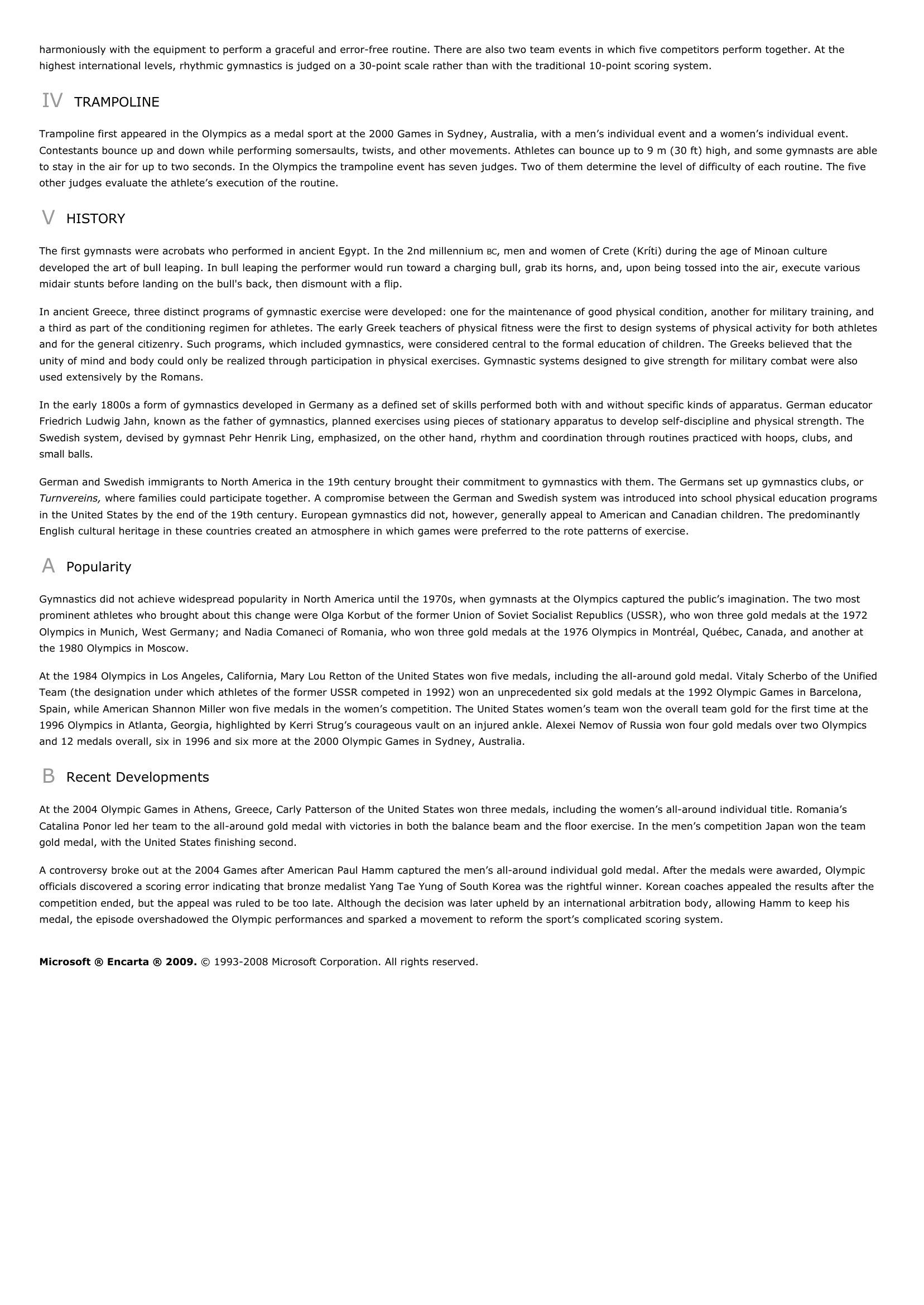Gymnastics.
Publié le 14/05/2013

Extrait du document
«
harmoniously with the equipment to perform a graceful and error-free routine.
There are also two team events in which five competitors perform together.
At thehighest international levels, rhythmic gymnastics is judged on a 30-point scale rather than with the traditional 10-point scoring system.
IV TRAMPOLINE
Trampoline first appeared in the Olympics as a medal sport at the 2000 Games in Sydney, Australia, with a men’s individual event and a women’s individual event.Contestants bounce up and down while performing somersaults, twists, and other movements.
Athletes can bounce up to 9 m (30 ft) high, and some gymnasts are ableto stay in the air for up to two seconds.
In the Olympics the trampoline event has seven judges.
Two of them determine the level of difficulty of each routine.
The fiveother judges evaluate the athlete’s execution of the routine.
V HISTORY
The first gymnasts were acrobats who performed in ancient Egypt.
In the 2nd millennium BC, men and women of Crete (Kríti) during the age of Minoan culture developed the art of bull leaping.
In bull leaping the performer would run toward a charging bull, grab its horns, and, upon being tossed into the air, execute variousmidair stunts before landing on the bull's back, then dismount with a flip.
In ancient Greece, three distinct programs of gymnastic exercise were developed: one for the maintenance of good physical condition, another for military training, anda third as part of the conditioning regimen for athletes.
The early Greek teachers of physical fitness were the first to design systems of physical activity for both athletesand for the general citizenry.
Such programs, which included gymnastics, were considered central to the formal education of children.
The Greeks believed that theunity of mind and body could only be realized through participation in physical exercises.
Gymnastic systems designed to give strength for military combat were alsoused extensively by the Romans.
In the early 1800s a form of gymnastics developed in Germany as a defined set of skills performed both with and without specific kinds of apparatus.
German educatorFriedrich Ludwig Jahn, known as the father of gymnastics, planned exercises using pieces of stationary apparatus to develop self-discipline and physical strength.
TheSwedish system, devised by gymnast Pehr Henrik Ling, emphasized, on the other hand, rhythm and coordination through routines practiced with hoops, clubs, andsmall balls.
German and Swedish immigrants to North America in the 19th century brought their commitment to gymnastics with them.
The Germans set up gymnastics clubs, orTurnvereins, where families could participate together.
A compromise between the German and Swedish system was introduced into school physical education programs in the United States by the end of the 19th century.
European gymnastics did not, however, generally appeal to American and Canadian children.
The predominantlyEnglish cultural heritage in these countries created an atmosphere in which games were preferred to the rote patterns of exercise.
A Popularity
Gymnastics did not achieve widespread popularity in North America until the 1970s, when gymnasts at the Olympics captured the public’s imagination.
The two mostprominent athletes who brought about this change were Olga Korbut of the former Union of Soviet Socialist Republics (USSR), who won three gold medals at the 1972Olympics in Munich, West Germany; and Nadia Comaneci of Romania, who won three gold medals at the 1976 Olympics in Montréal, Québec, Canada, and another atthe 1980 Olympics in Moscow.
At the 1984 Olympics in Los Angeles, California, Mary Lou Retton of the United States won five medals, including the all-around gold medal.
Vitaly Scherbo of the UnifiedTeam (the designation under which athletes of the former USSR competed in 1992) won an unprecedented six gold medals at the 1992 Olympic Games in Barcelona,Spain, while American Shannon Miller won five medals in the women’s competition.
The United States women’s team won the overall team gold for the first time at the1996 Olympics in Atlanta, Georgia, highlighted by Kerri Strug’s courageous vault on an injured ankle.
Alexei Nemov of Russia won four gold medals over two Olympicsand 12 medals overall, six in 1996 and six more at the 2000 Olympic Games in Sydney, Australia.
B Recent Developments
At the 2004 Olympic Games in Athens, Greece, Carly Patterson of the United States won three medals, including the women’s all-around individual title.
Romania’sCatalina Ponor led her team to the all-around gold medal with victories in both the balance beam and the floor exercise.
In the men’s competition Japan won the teamgold medal, with the United States finishing second.
A controversy broke out at the 2004 Games after American Paul Hamm captured the men’s all-around individual gold medal.
After the medals were awarded, Olympicofficials discovered a scoring error indicating that bronze medalist Yang Tae Yung of South Korea was the rightful winner.
Korean coaches appealed the results after thecompetition ended, but the appeal was ruled to be too late.
Although the decision was later upheld by an international arbitration body, allowing Hamm to keep hismedal, the episode overshadowed the Olympic performances and sparked a movement to reform the sport’s complicated scoring system.
Microsoft ® Encarta ® 2009. © 1993-2008 Microsoft Corporation.
All rights reserved..
»
↓↓↓ APERÇU DU DOCUMENT ↓↓↓
Liens utiles
- Women's Individual Gymnastics: Olympic Gold Medalists.
- Men's Individual Gymnastics: Olympic Gold Medalists.
- Gymnastics World Champions.
- Men's Individual Gymnastics: Olympic Gold Medalists Year Name Country 1900 Gustav Sandras France 1904 Julius Lenhart Austria Pierre Paysse France 1906 Pierre Paysse France 1908 Alberto
- Gymnastics World Champions.

































